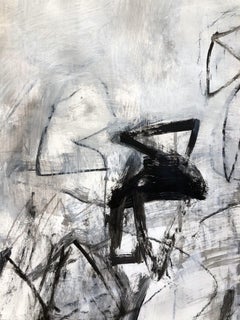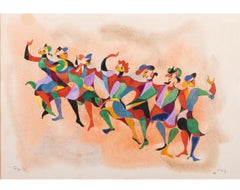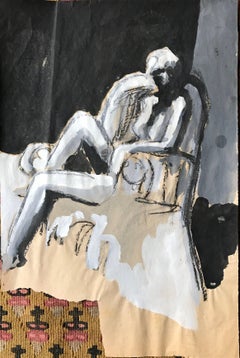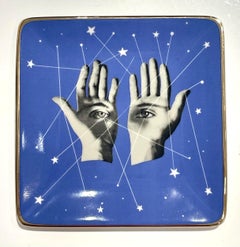Bauhaus Mixed Media
to
2
1
1
1
1
Overall Height
to
Overall Width
to
10,072
7,400
1,585
1,028
761
427
282
175
132
114
51
23
22
5
1
1
1
2
1
1
1
1
Style: Bauhaus
Resonate l
Located in East Hampton, NY
Resonate l , mixed media on paper
Comes UNFRAMED
Black and white abstract mixed media on paper
About the Artist: Julie Schumer, a native of Los Angeles, California, and born in 195...
Category
2010s Bauhaus Mixed Media
Materials
Mixed Media, Archival Paper
Bauhaus Moshe Raviv Moi Ver Abstract Dancing Painting Lithuanian Israeli Modern
Located in Surfside, FL
Dancing Jesters or Clowns (colorful Chassidim dancing)
Gouache on paper
Sheet is 19.25 X 25.25
Image is 13.5 X 19.25
Moshé Raviv-Vorobeichic, known as Moi Ver, born Moses Vorobeichik (1904–1995) was an Israeli photographer and painter.
Moi Ver (Moshe Raviv) was born in 1904 in Vilnius, Lithuania as Moshe Vorobeichic.
Moshe Vorobeichic received his initial artistic training in the early 1920s in Vilnius, Lithuania, where he studied painting, architecture, and photography. Having become an important figure in the Yiddish avant-garde culture, he exhibited his first works. From October 1927, he studied at the Bauhaus school in Dessau (Germany), with photographer-visual artist Laszlo Moholy Nagy and painters Josef Albers, Paul Klee, Wassily Kandinsky, and Hinnerk Scheper.
In his book Moi Ver: Paris, he produced avant-garde photomontages. Originally published in 1931 by Editions Jeanne Walter with an introduction by futurist Fernand Leger.
In 1932 Raviv was sent by the weekly La Vie Parisienne to British Mandate Palestine as photo reporter. Raviv illustrated many books. Raviv was a founder of the Artists' Colony in Safed.
At the height of 20th Century modernism and one of the followers of Laszlo Moholy Nagy and his concept of New Vision, Moin Ver was one of the rising stars in European photography. Born in Lebedeva, in Belarus, he wandered through Europe until he immigrated to Palestine in 1934. His well known yet partly forgotten three photographic projects in 1931, The Ghetto Lane in Wilna, Paris: 80 Photographies de Moi Ver and Ci-Contre – 110 Photos de Moi Ver (that was not published at the time), have remained milestones in the art of the 1930s as he created and imposed a new visionary style in photography.
As a contemporary of artists such as Man Ray, Ilse Bing...
Category
20th Century Bauhaus Mixed Media
Materials
Paper, Gouache
Related Items
"Leaning in Chair" Mid-Century Figurative
Located in Arp, TX
Gloria Dudfield
Leaning in Chair
1960's
Gouache and Charcoal on Paper
11.75"x17.75" unframed.
Gloria (Fischer) Dudfield
July 12, 1922 – May 27, 2015
Came from a portfolio of her wor...
Category
Mid-20th Century Bauhaus Mixed Media
Materials
Paper, Charcoal, Gouache
Things to Come tray
Located in New York, NY
Herbert Bayer
Things to Come tray, 2018
Porcelain dish with metallic gold edge and silkscreened image
Limited edition of an unknown quantity, originally distributed by the Museum of Modern Art, before it sold out.
Measurements:
Box:
5.5 x 5.5 inches
Tray:
5 x 5 inches
Provenance:
Originally distributed by the Museum of Modern Art, before it sold out
Manufacturer:
Galison Publishing LLC and The Museum of Modern Art
Herbert Bayer biography:
Artistic polymath Herbert Bayer was one of the Bauhaus’s most influential students, teachers, and proponents, advocating the integration of all arts throughout his career. Bayer began his studies as an architect in 1919 in Darmstadt. From 1921 to 1923 he attended the Bauhaus in Weimar, studying mural painting with Vasily Kandinsky and typography, creating the Universal alphabet, a typeface consisting of only lowercase letters that would become the signature font of the Bauhaus. Bayer returned to the Bauhaus from 1925 to 1928 (moving in 1926 to Dessau, its second location), working as a teacher of advertising, design, and typography, integrating photographs into graphic compositions.
He began making his own photographs in 1928, after leaving the Bauhaus; however, in his years as a teacher the school was a fertile ground for the New Vision photography passionately promoted by his close colleague László Moholy-Nagy, Moholy-Nagy’s students, and his Bauhaus publication Malerei, Photographie, Film (Painting, photography, film). Most of Bayer’s photographs come from the decade 1928–38, when he was based in Berlin working as a commercial artist. They represent his broad approach to art, including graphic views of architecture and carefully crafted montages.
In 1938 Bayer emigrated to the United States with an invitation from Alfred H. Barr, Jr., founding director of The Museum of Modern Art, to apply his theories of display to the installation of the exhibition Bauhaus: 1919–28 (1938) at MoMA. Bayer developed this role through close collaboration with Edward Steichen, head of the young Department of Photography, designing the show Road to Victory (1942), which would set the course for Steichen’s influential approach to photography exhibition. Bayer remained in America working as a graphic designer for the remainder of his career.
-Courtesy of MOMA
More about Herbert Bayer:
Herbert Bayer (1900-1985) was born in Austria, where he entered into an apprenticeship under the architect and designer, Georg Smidthammer, with whom Bayer learned drawing, painting, and architectural drafting, inspired by nature and without formal knowledge of art history. In 1920, Bayer discovered the theoretical writings of the artist Vassily Kandinsky, as well as Walter Gropius’ 1919 Bauhaus manifesto, in which Gropius declared the necessity for a return to crafts, in which were found true creativity and inspiration. Bayer traveled to Weimar to meet Gropius in October of 1921 and was immediately accepted into the Bauhaus. There, he was deeply influenced by the instruction of Kandinsky, Johannes Itten and Paul Klee.
In 1928 Bayer moved to Berlin together with several members of the Bauhaus staff including Gropius, Moholy-Nagy and Marcel Breuer. He found work as a freelance graphic designer, particularly with German Vogue, under its art director Agha. When the latter returned to Paris, Bayer joined the staff full time, and also worked increasingly with Dorland, the magazine's principle advertising agency. It was in the period from 1928 to his emigration to America in 1938 that he developed his unique vision as an artist, combining a strongly modernist aesthetic sense with a rare ability to convey meaning clearly and directly. This seamless combination of art, craft and design mark Bayer as true prophet of Bauhaus theories.
Bayer followed Gropius to America in 1938, and set his breadth of skills to work later that year in designing the landmark Bauhaus 1918-1928 exhibition at the Museum of Modern Art. Bayer flourished in New York as a designer and architect, but it was his meeting with the industrialist Walter Paepcke in 1946 that allowed him to harness his concepts of 'total design' to the postwar boom. Paepcke was developing Aspen as a cultural and intellectual destination, and found in Bayer the perfect collaborator. Bayer was designer, educator and indeed architect for Paepcke's Aspen Institute...
Category
2010s Bauhaus Mixed Media
Materials
Metal
"Side Stretch Nude" 1984 Figure Gouache and Pastel American Modernist
By Jack Hooper
Located in Arp, TX
Jack Hooper
"Side Stretch Nude"
9/7/1984
Gouache and pastel on paper
20"x26" unframed
Signed and dated in pencil lower left
In this intriguing modernist artwork, Jack Hooper's minim...
Category
1980s Bauhaus Mixed Media
Materials
Paper, Pastel, Gouache
"Side Stretch Nude 3" 1984 Figure Gouache and Pastel American Modernist
By Jack Hooper
Located in Arp, TX
Jack Hooper
"Side Stretch Nude 3"
9/7/1984
Gouache and pastel on paper
20"x26" unframed
Signed and dated in pencil lower right
In this exemplary work of modernist art, Jack Hooper e...
Category
1980s Bauhaus Mixed Media
Materials
Paper, Pastel, Gouache
"Side Stretch Nude 2" 1984 Figure Gouache and Pastel American Modernist
By Jack Hooper
Located in Arp, TX
Jack Hooper
"Side Stretch Nude 2"
9/7/1984
Gouache and pastel on paper
20"x26" unframed
Signed and dated in pencil lower right
In this modernist masterpiece, Jack Hooper deftly navi...
Category
1980s Bauhaus Mixed Media
Materials
Paper, Pastel, Gouache
James Prestini : Grouping of Turned Wooden Bowls
Located in Fresno, CA
Trio of turned wood bowls by the internationally known American Sculptor, Designer and Craftsman, James L. Prestini, (1908-1993). Prestini’s masterfu...
Category
Mid-20th Century Bauhaus Mixed Media
Materials
Birch
Mid Century Figurative Painting Purple, Orange, Gray, Yellow Pastel and Paint
Located in Arp, TX
Gloria Dudfield (1922-2015)
Untitled
c.1960s
Mixed media: gouache, pastel and encaustic on newsprint
12"x19.5" paper cut unevenly, unframed
Unsigned
Gloria (Fischer) Dudfield
July 1...
Category
Mid-20th Century Bauhaus Mixed Media
Materials
Paper, Pastel, Encaustic, Gouache
Reclining With Tulips: Contemporary Figurative Mixed Media Painting
By John Emanuel
Located in Brecon, Powys
Classic John Emanuel figurative painting.
Mixed media on paper, signed and well framed. Excellent condition
Framed 13" x 16". Image 7.5" x 10.25"
21st Century
Category
Early 2000s Bauhaus Mixed Media
Materials
Charcoal, Oil, Gouache
Dance Night, 8"x8", Giclée Print W/Hand Painted Embellishments, Black And White
Located in Mississauga, Ontario
This dress evokes a sense of femininity, grace and timeless charm. The one-of-a-kind Giclée print is a high-quality reproduction of an original artwork printed on archival paper. Han...
Category
2010s Bauhaus Mixed Media
Materials
Textile, Mixed Media, Acrylic, Archival Paper, Giclée
Sunny Side Of Life
Located in Los Angeles, CA
Internationally acclaimed artist Martina Niederhauser presents a new collection that offers fresh perspectives on women, delving into the realms of emotion, beauty, identity, and the...
Category
21st Century and Contemporary Bauhaus Mixed Media
Materials
Canvas, Mixed Media, Oil, Acrylic, Gouache, Archival Paper
Covered In Lace , 8"x8", Giclée Print With Hand Embellishments, Black And White
Located in Mississauga, Ontario
This lace dress evokes a sense of femininity, grace and timeless charm. The one-of-a-kind Giclée print is a high-quality reproduction of an original artwork printed on archival paper...
Category
2010s Bauhaus Mixed Media
Materials
Mixed Media, Acrylic, Giclée, Textile, Archival Paper
Homage To Chanel - 5"x5" Artwork, 10"x10" Frame, Black And White, Red, Small Art
Located in Mississauga, Ontario
Homage to the iconic Chanel Brand. This original artwork on paper combines textured brush strokes and textile collage elements. Surrounded by heavy texture, the focal point is a deta...
Category
2010s Bauhaus Mixed Media
Materials
Mixed Media, Acrylic, Textile, Ink, Archival Paper
Bauhaus mixed media for sale on 1stDibs.
Find a wide variety of authentic Bauhaus mixed media available for sale on 1stDibs. Works in this style were very popular during the 21st Century and Contemporary, but contemporary artists have continued to produce works inspired by this movement. Many Pop art paintings were created by popular artists on 1stDibs, including and Julie Schumer. Frequently made by artists working with Paper, and Archival Paper and other materials, all of these pieces for sale are unique and have attracted attention over the years. Not every interior allows for large Bauhaus mixed media, so small editions measuring 25.25 inches across are also available. Prices for mixed media made by famous or emerging artists can differ depending on medium, time period and other attributes. On 1stDibs, the price for these items starts at $1,500 and tops out at $2,600, while the average work sells for $2,050.



